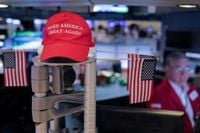On July 7, 2025, the New York stock market experienced a notable downturn, with all three major indices—the Dow Jones Industrial Average, the S&P 500, and the Nasdaq Composite—closing sharply lower. This market decline was primarily driven by renewed concerns over escalating global trade tensions following U.S. President Donald Trump's announcement of imposing significant tariffs on several key trading partners, including South Korea and Japan.
The Dow Jones Industrial Average fell by 422.17 points, or 0.94%, closing at 44,406.36. The S&P 500 index dropped 49.37 points, or 0.79%, to 6,229.98, while the Nasdaq Composite index fell 188.59 points, or 0.92%, ending the day at 24,412.52. These declines marked the largest drops for these indices since mid-June, signaling growing investor unease amid the tariff announcements and other market pressures.
President Trump publicly shared, via his social media platform Truth Social, a signed letter addressed to the leaders of seven countries—South Korea, Japan, Malaysia, Kazakhstan, South Africa, Laos, and Myanmar—informing them that a 25% import tariff would be imposed starting August 1, 2025. For South Korea, the tariff rate remained consistent with the reciprocal tariff rate announced earlier in April, while Japan's rate was increased by one percentage point. Trump emphasized the severity of his measures by labeling the tariff rates as "high-grade," underscoring the administration's firm stance.
In addition to these seven countries, the White House confirmed that 12 other nations would also receive similar tariff letters, broadening the scope of this trade policy. Trump further threatened to impose an additional 10% tariff on countries within the BRICS group—Brazil, Russia, India, China, and South Africa—if they align with what he termed "anti-U.S. policies." This escalation added another layer of uncertainty and concern to global trade relations.
White House Press Secretary Karoline Leavitt announced that 14 tariff letters were dispatched on July 7, with more to follow on July 8, and that President Trump signed an executive order extending the grace period for implementing these reciprocal tariffs until August 1, 2025. This extension effectively allows an additional three weeks for negotiations, though it did little to assuage market fears.
Market analysts observed that the reemergence of tariff risks heightened investor anxiety, prompting a cautious retreat from equities. Emily Roland, co-chief investment strategist at Manulife John Hancock Investment Management, told Reuters, "Tariffs are back on the table, increasing anxiety, and investors are pulling back." The uncertainty surrounding tariffs also complicated the Federal Reserve's monetary policy outlook, as inflation concerns resurfaced. The Fed's June meeting minutes, due for release on July 9, are expected to shed light on future interest rate decisions. According to the CME Group's FedWatch Tool, traders see a 95% chance of a rate freeze in July, with about a 60% probability of a rate cut in September.
The tariff announcements also had immediate repercussions on individual stocks, particularly in the automotive and technology sectors. Shares of Toyota Motor and Honda Motor fell approximately 4% each following Trump's social media post, reflecting investor worries about the 25% tariffs on automobiles and the 50% tariffs on steel and aluminum that are separate from the reciprocal tariffs. Wendy Cutler, vice president of the Asia Society Policy Institute, noted, "This announcement suggests the U.S. will not consider tariff reductions for items subject to 'Trade Expansion Act Section 232,' including automobiles, signaling a firm stance on this critical issue for both South Korea and Japan."
Tesla's stock suffered a significant blow, plunging nearly 7% to $293.94, marking its first close below $300 since early June. This decline was fueled not only by tariff fears but also by escalating political tensions between Tesla CEO Elon Musk and President Trump. Musk's recent announcement of forming a new political party, the "America Party," and his deeper involvement in politics have further strained relations. CNBC highlighted that the worsening conflict between Musk and Trump, alongside tariff anxieties, weighed heavily on Tesla's stock and the broader Nasdaq 100 index, which itself declined 0.79% to 22,685.57. Other tech stocks such as ARM Holdings (-5.29%), Marvell Technology Group (-4.83%), and Lululemon Athletica (-4.08%) also experienced sharp declines.
On the flip side, some companies bucked the downward trend. Palantir Technologies, an AI defense contractor, rose 3.54%, and other firms like DoorDash, Constellation Energy, and Booking Holdings also posted gains, helping to somewhat offset the Nasdaq's losses.
Apple and Alphabet were among the tech giants that declined, with Apple falling 1.69% to $209.95 and Alphabet dropping 1.66% to $177.56. Peter Navarro, former White House trade advisor, reportedly criticized Apple's pace in moving operations out of China, which may have contributed to the stock's weakness. Microsoft slid 0.22% to $497.72, while Amazon was a rare bright spot, edging up 0.03% to $223.47.
The tariff announcement also impacted Korean companies listed in the U.S. market. SK Telecom's shares dropped over 7%, and LG Display fell more than 6%, reflecting investor concerns about the tariffs' effects on Korean exports.
Beyond equities, the tariffs influenced currency and bond markets. The won-dollar exchange rate surged to 1,380.26 won per dollar shortly after the announcement, its highest level in two weeks, before settling at 1,375.93 won, nearly 1% higher than the previous day. The yen also strengthened, with the dollar-yen rate climbing 1.15% to 146.15 yen. Treasury yields rose as well, with the 10-year yield increasing by 4.9 basis points to 4.389%, and the 2-year yield rising 1.7 basis points to 3.899%, signaling market expectations of inflationary pressures and potential Fed responses.
International oil prices climbed amid these developments. Despite OPEC+ agreeing to increase production by 548,000 barrels per day in August, Saudi Arabia unexpectedly raised crude oil export prices to Asia, signaling confidence in strong demand. West Texas Intermediate (WTI) crude for August delivery closed at $67.93 per barrel, up 1.38%, while Brent crude for September delivery rose 1.87% to $69.58 per barrel.
The market's reaction to these intertwined political, trade, and economic developments underscores the fragility of investor sentiment in the face of geopolitical uncertainty. As the August 1 deadline for tariff implementation approaches, all eyes will be on the ongoing negotiations and the Federal Reserve's forthcoming policy signals to gauge the trajectory of markets and global trade relations.


![다시 커진 트럼프 '고율 관세' 우려…나스닥 0.9%↓[월스트리트in]](https://thumbor.evrimagaci.org/7ucG0GaiVzoJ-RP81gl_afs784k=/200x0/tpg%2Fsources%2F61c591f1-fced-404e-ab00-f97c8c0b6f24.jpeg)



